Rapid Nondestructive Detection of Water Content and Granulation in Postharvest “Shatian” Pomelo Using Visible/Near-Infrared Spectroscopy
Abstract
1. Introduction
2. Materials and Methods
2.1. Experimental “Shatian”Pomelo
2.2. VIS/NIR Spectrum Sampling
2.3. Water Content and Granulation Degree Test
2.4. Data Analysis Methods
2.4.1. Singular Sample Removal
2.4.2. Data Preprocessing
2.4.3. Feature Selection
2.4.4. Classification and Detection
2.4.5. Analysis Parameter Setting
2.4.6. Software Applied
3. Results and Discussion
3.1. Water Content Detection
3.1.1. Detection Based on Raw Data
3.1.2. Detection Based on Data Processing Methods
3.1.3. Detection Based on Feature Selection Methods
3.2. Granulation Degree Detection
3.2.1. LDA Classification Based on Raw Data
3.2.2. LDA Classification Based on Different Data Processing Methods
3.2.3. PLSR Detection Based on SG Processed Data
3.3. Relationship between Water Content and Granulation Degree
3.4. Discussion
4. Conclusions
Author Contributions
Funding
Conflicts of Interest
References
- Fu, X.M.; Li, J.X.; Mao, J.M.; Liu, H.M.; Du, Y.X.; Gao, J.Y.; Long, C.R.; Shen, Z.S.; Yue, J.Q. Analysis and Prospect of Production and Marketing Situation of Grapefruit (inc.Pomelos) in the China and World. Chin. J. Trop. Agric. 2018, 38, 114–122. Available online: http://en.cnki.com.cn/Article_en/CJFDTotal-RDNK201801021.htm (accessed on 11 March 2020).
- Burns, J.K.; Albrigo, L.G. Time of Harvest and Method of Storage Affect Granulation in Grapefruit. Hortscience Publ. Am. Soc. Hortic. Sci. 1998, 33, 728–730. [Google Scholar] [CrossRef]
- Diao, J.M.; Zhong, C.G. Relation between Moisture Content and Granulation of Shatian Shaddock During Storage. ACTA Agric. Nucleatae Sin. 1999, 13, 223–228. [Google Scholar] [CrossRef]
- He, L.G.; Jiang, Y.C.; Wang, Z.J.; Wu, L.M.; Tong, Z.; Xu, M.; Sun, Z.H. The Relationship between Quality Parameters and Granulation in Different Pomelo Fruits during Normal Storage. Hubei Agric. Sci. 2014, 53, 6038–6044. [Google Scholar] [CrossRef]
- Thielen, M.; Speck, T.; Seidel, R. Viscoelasticity and compaction behaviour of the foam-like pomelo (Citrus maxima) peel. J. Mater. Sci. 2013, 48, 3469–3478. [Google Scholar] [CrossRef]
- Cheong, M.W.; Liu, S.Q.; Zhou, W.; Curran, P.; Yu, B. Chemical composition and sensory profile of pomelo (Citrus grandis (L.) Osbeck) juice. Food Chem. 2012, 135, 2505–2513. [Google Scholar] [CrossRef]
- Sirisomboon, P.; Lapchareonsuk, R. Evaluation of the physicochemical and textural properties of pomelo fruit following storage. Fruits 2012, 67, 399–413. [Google Scholar] [CrossRef]
- Zheng, Y.M.; Zhang, X.X.; Zeng, P.P.; Lu, Y.-Z.; Lu, X.-L.; Zeng, J.M. Effect of Cold Shock on Quality of Guanxi Honey Pomelo Fruits Stored at Room Temperature. Food Sci. 2010, 31, 496–499. Available online: http://www.spkx.net.cn/EN/abstract/abstract8802.shtml (accessed on 11 March 2020).
- Liu, T.; Ehsani, R.; Toudeshki, A.; Zou, X.; Wang, H. Identifying immature and mature pomelo fruits in trees by elliptical model fitting in the Cr–Cb color space. Precis. Agric. 2019, 20, 138–156. [Google Scholar] [CrossRef]
- Leemans, V. AE—Automation and Emerging Technologies:On-line fruit grading according to their external quality using machine vision. Biosyst. Eng. 2002, 83, 397–404. [Google Scholar] [CrossRef]
- Pan, X.; Sun, L.; Li, Y.; Che, W.; Ji, Y.; Li, J.; Li, J.; Xie, X.; Xu, Y. Non-Destructive Classification of Apple Bruising Time Based on Visible and Near-infrared Hyperspectral Imaging. J. Sci. Food Agric. 2019, 99, 1709–1718. [Google Scholar] [CrossRef]
- Cen, H.; He, Y.; Huang, M. Combination and comparison of multivariate analysis for the identification of orange varieties using visible and near infrared reflectance spectroscopy. Eur. Food Res. Technol. 2007, 225, 699–705. [Google Scholar] [CrossRef]
- Shao, Y.; Bao, Y.; He, Y. Visible/Near-Infrared Spectra for Linear and Nonlinear Calibrations: A Case to Predict Soluble Solids Contents and pH Value in Peach. Food Bioprocess Technol. 2011, 4, 1376–1383. [Google Scholar] [CrossRef]
- Mcglone, V.A.; Clark, C.J.; Jordan, R.B. Comparing density and VNIR methods for predicting quality parameters of yellow-fleshed kiwifruit (Actinidia chinensis). Postharvest Biol. Technol. 2007, 46, 1–9. [Google Scholar] [CrossRef]
- Ncama, K.; Opara, U.L.; Tesfay, S.Z.; Fawole, O.A.; Magwaza, L.S. Application of Vis/NIR spectroscopy for predicting sweetness and flavour parameters of ‘Valencia’ orange ( Citrus sinensis ) and ‘Star Ruby’ grapefruit (Citrus x paradisi Macfad). J. Food Eng. 2017, 193, 86–94. [Google Scholar] [CrossRef]
- Ozaki, Y. Near-Infrared Spectroscopy-Its Versatility in Analytical Chemistry. Anal. Sci. Int. J. Jpn. Soc. Anal. Chem. 2012, 28, 545–563. Available online: https://www.jsac.or.jp/analsci/abst.php/28/6/545 (accessed on 11 March 2020). [CrossRef]
- Nagpala, E.G.L.; Noferini, M.; Farneti, B.; Piccinini, L.; Costa, G. Cherry-Meter: An innovative non-destructive (vis/NIR) device for cherry fruit ripening and quality assessment. Acta Hortic. 2017, 491–496. [Google Scholar] [CrossRef]
- Gomez, A.H.; He, Y.; Pereira, A.G. Non-destructive measurement of acidity, soluble solids and firmness of Satsuma mandarin using Vis/NIR-spectroscopy techniques. J. Food Eng. 2006, 77, 313–319. [Google Scholar] [CrossRef]
- Jie, D.; Xuan, W. Review on the recent progress of non-destructive detection technology for internal quality of watermelon. Comput. Electron. Agric. 2018, 151, 156–164. [Google Scholar] [CrossRef]
- Zhang, D.; Xu, L.; Wang, Q.; Tian, X.; Li, J. The Optimal Local Model Selection for Robust and Fast Evaluation of Soluble Solid Content in Melon with Thick Peel and Large Size by Vis-NIR Spectroscopy. Food Anal. Method 2019, 12, 136–147. [Google Scholar] [CrossRef]
- Hu, W.R.; Kong, W.N.; Yang, X.Q.; Liu, S.Z.; Zhang, S.Q. Effects of two storage temperatures on storage quality of Shatianyu pomelo. Food Sci. Technol.-Brazil 2015, 40, 334–339. [Google Scholar] [CrossRef]
- Hu, W.R.; Liu, S.Z.; Jiang, Y.L.; Lin, R.Y.; Wang, Y.L.; Li, B.L. Characteristics of Granulated Juice Sacs of Red-Fleshed Sweet Pomelo. Food Sci. 2015, 36, 257–262. [Google Scholar] [CrossRef]
- Xu, S.; Sun, X.; Lu, H.; Yang, H.; Ruan, Q.; Huang, H.; Chen, M. Detecting and Monitoring the Flavor of Tomato (Solanum lycopersicum) under the Impact of Postharvest Handlings by Physicochemical Parameters and Electronic Nose. Sensors 2018, 18, 1847. [Google Scholar] [CrossRef] [PubMed]
- Liu, Y.; Zhou, Y. Quantification of the Soluble Solids Content of Intact Apples by Vis-NIR Transmittance Spectroscopy and the LS-SVM Method. Spectroscopy 2013, 28, 32–43. Available online: http://www.spectroscopyonline.com/quantification-soluble-solids-content-intact-apples-vis-nir-transmittance-spectroscopy-and-ls-svm-me (accessed on 11 March 2020). [CrossRef]
- Cheng, S.H.; Higham, N.J.; Kenney, C.S.; Laub, A.J. Approximating the Logarithm of a Matrix to Specified Accuracy. Siam J. Matrix Anal. Appl. 2001, 22, 1112–1125. [Google Scholar] [CrossRef]
- Chu, Z.; Ning, X.; Luo, L.; Fei, L.; Kong, W. Detection of Aspartic Acid in FermentedCordycepsPowder Using Near Infrared Spectroscopy Based on Variable Selection Algorithms and Multivariate Calibration Methods. Food Bioprocess Technol. 2014, 7, 598–604. [Google Scholar] [CrossRef]
- Palmblad, M.; Mills, D.J.; Bindschedler, L.V.; Cramer, R. Chromatographic Alignment of LC-MS and LC-MS/MS Datasets by Genetic Algorithm Feature Extraction. J. Am. Soc. Mass. Spectr. 2007, 18, 1835–1843. [Google Scholar] [CrossRef] [PubMed]
- Yang, Z.R.; Zwolinski, M. Mutual information theory for adaptive mixture models. IEEE Trans. Pami. 2001, 23, 396–403. [Google Scholar] [CrossRef]
- Krafft, C.; Sobottka, S.B.; Geiger, K.D.; Schackert, G.; Salzer, R. Classification of malignant gliomas by infrared spectroscopic imaging and linear discriminant analysis. Anal. Bioanal. Chem. 2007, 387, 1669–1677. [Google Scholar] [CrossRef] [PubMed]
- Leone, A.P.; Viscarra-Rossel, R.A.; Amenta, P.; Buondonno, A. Prediction of Soil Properties with PLSR and vis-NIR Spectroscopy: Application to Mediterranean Soils from Southern Italy. Curr. Anal. Chem. 2012, 8, 283–299. [Google Scholar] [CrossRef]
- Xu, S.; Sun, X.; Lu, H.; Zhang, Q. Detection of Type, Blended Ratio, and Mixed Ratio of Pu’er Tea by Using Electronic Nose and Visible Near Infrared Spectrometer. Sensors 2019, 19, 2359. [Google Scholar] [CrossRef] [PubMed]
- Xu, S.; Lu, H.; Zhou, Z.; Lü, E.; Jiang, Y. Identification for guava mechanical damage based on combined hyper-spectrometer and electronic nose. Trans. Chin. Soc. Agric. Mach. 2015, 7, 214–219. [Google Scholar] [CrossRef]
- Pandit, J.J. The analysis of variance in anaesthetic research: Statistics, biography and history. Anaesthesia 2010, 65, 1212–1220. [Google Scholar] [CrossRef]
- Mireei, S.A.; Mohtasebi, S.S.; Massudi, R.; Rafiee, S.; Arabanian, A.S.; Berardinelli, A. Non-destructive measurement of moisture and soluble solids content of Mazafati date fruit by NIR spectroscopy. Aust. J. Crop Sci. 2010, 4, 175–179. Available online: https://search.informit.com.au/documentSummary;dn=216497474663046;res=IELHSS (accessed on 11 March 2020).
- Bag, S.K.; Srivastav, P.P.; Mishra, H.N. FT-NIR spectroscopy: A rapid method for estimation of moisture content in bael pulp. Brit. Food J. 2011, 113, 494–504. [Google Scholar] [CrossRef]
- Munshi, S.K.; Singh, R.; Vij, V.K.; Jawanda, J.S. Mineral composition of leaves in relation to degree of granulation in sweet orange. Sci. Hortic-Amst. 1978, 9, 357–367. [Google Scholar] [CrossRef]
- Dael, M.V.; Herremans, E.; Verboven, V.; Opara, U.L.; Lebotsa, S. Automated online detection of granulation in oranges using X-ray radiographs. Acta Hortic. 2016, 1119, 179–182. [Google Scholar] [CrossRef]
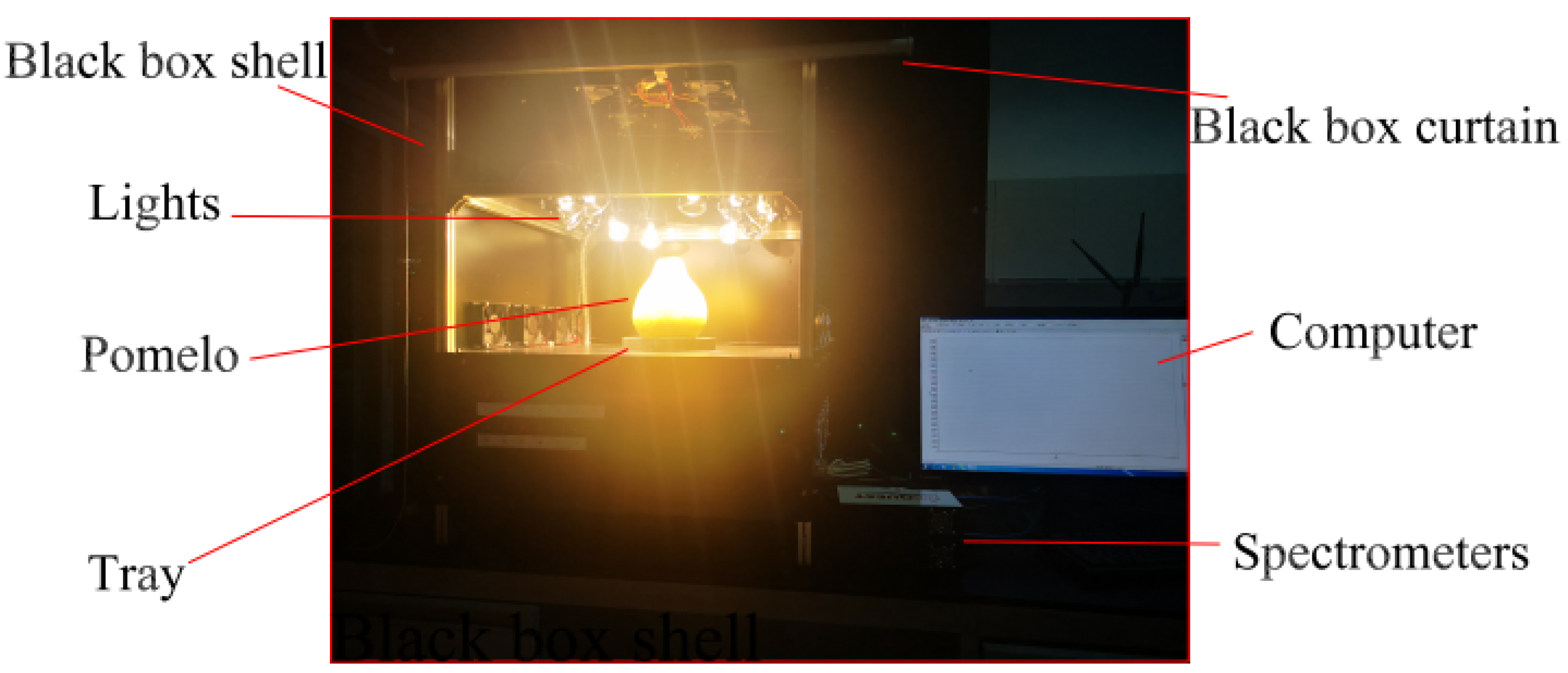
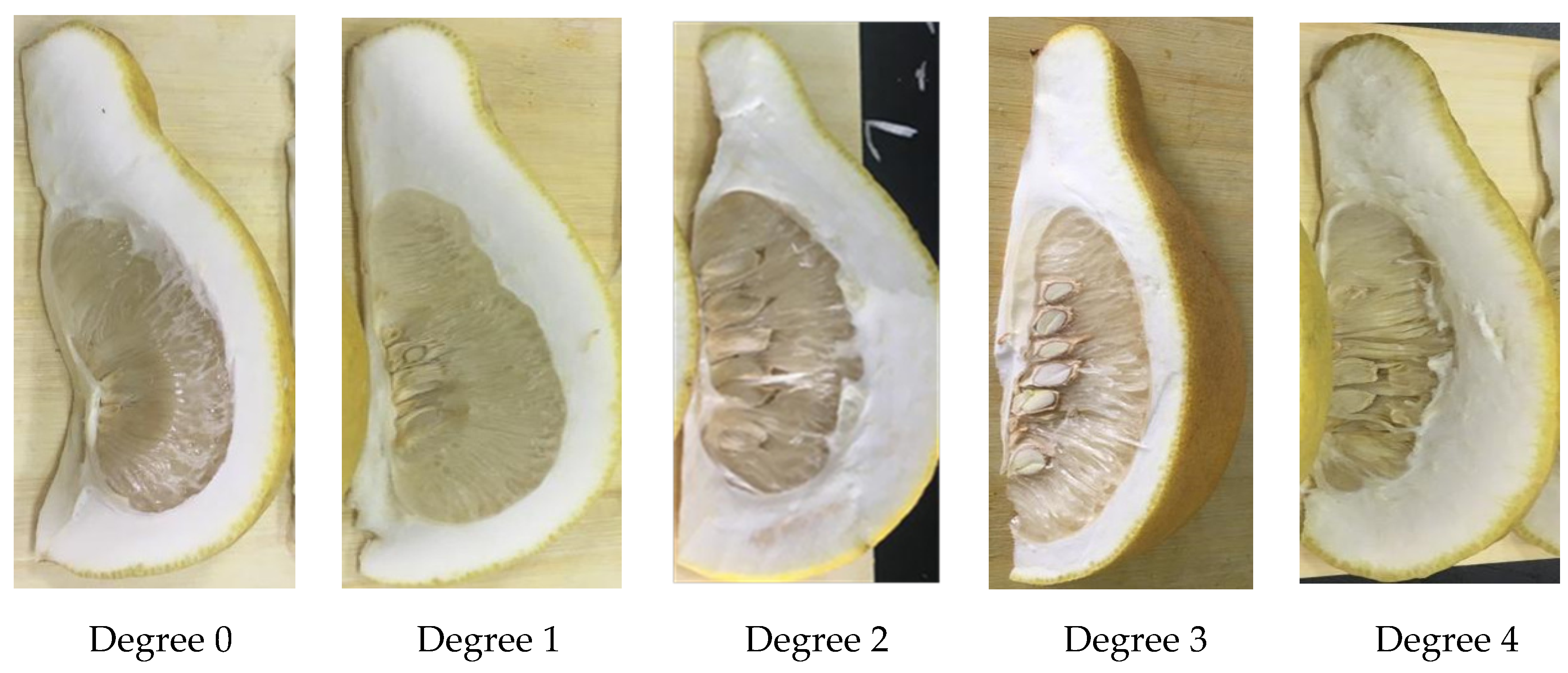
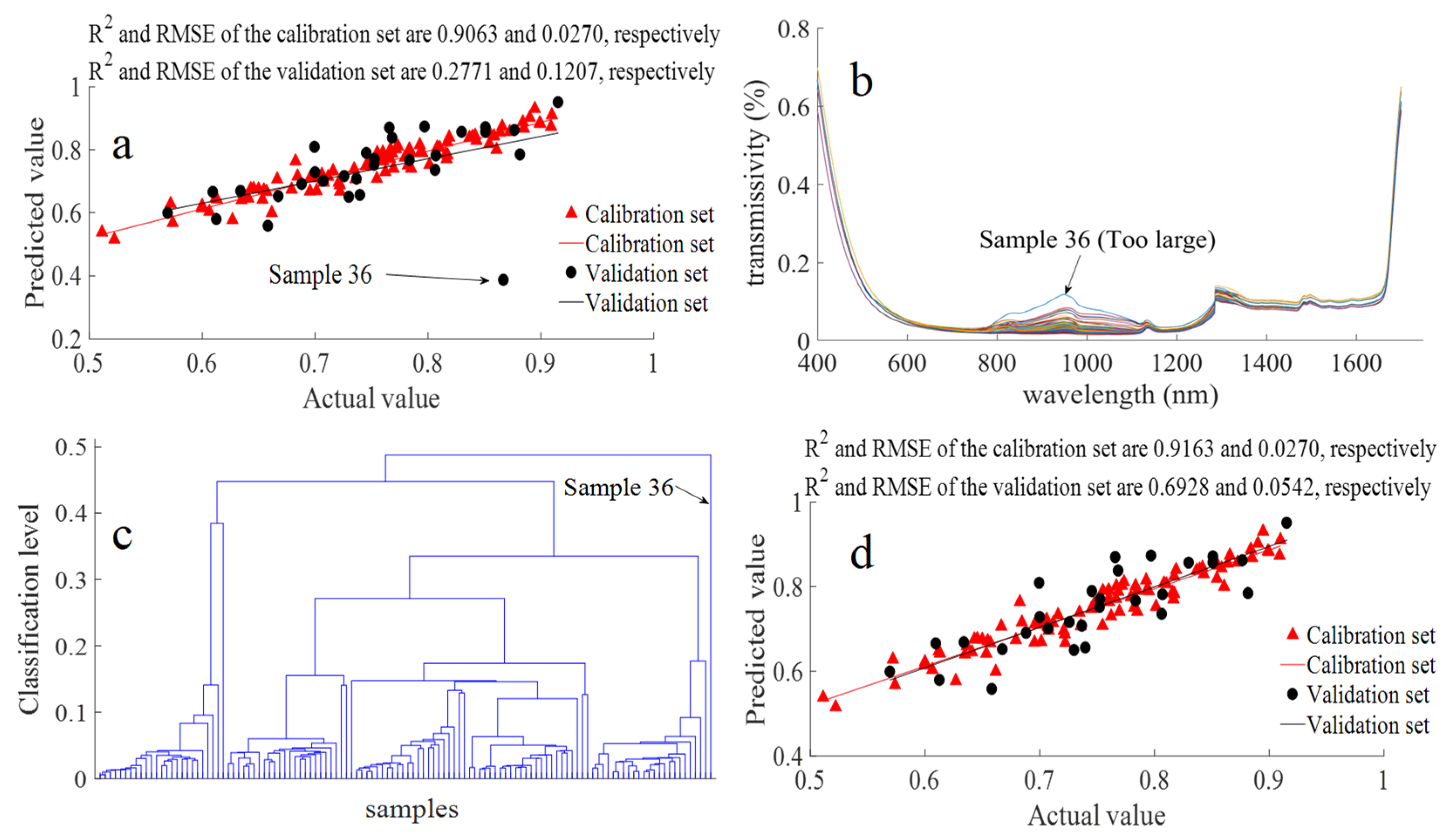
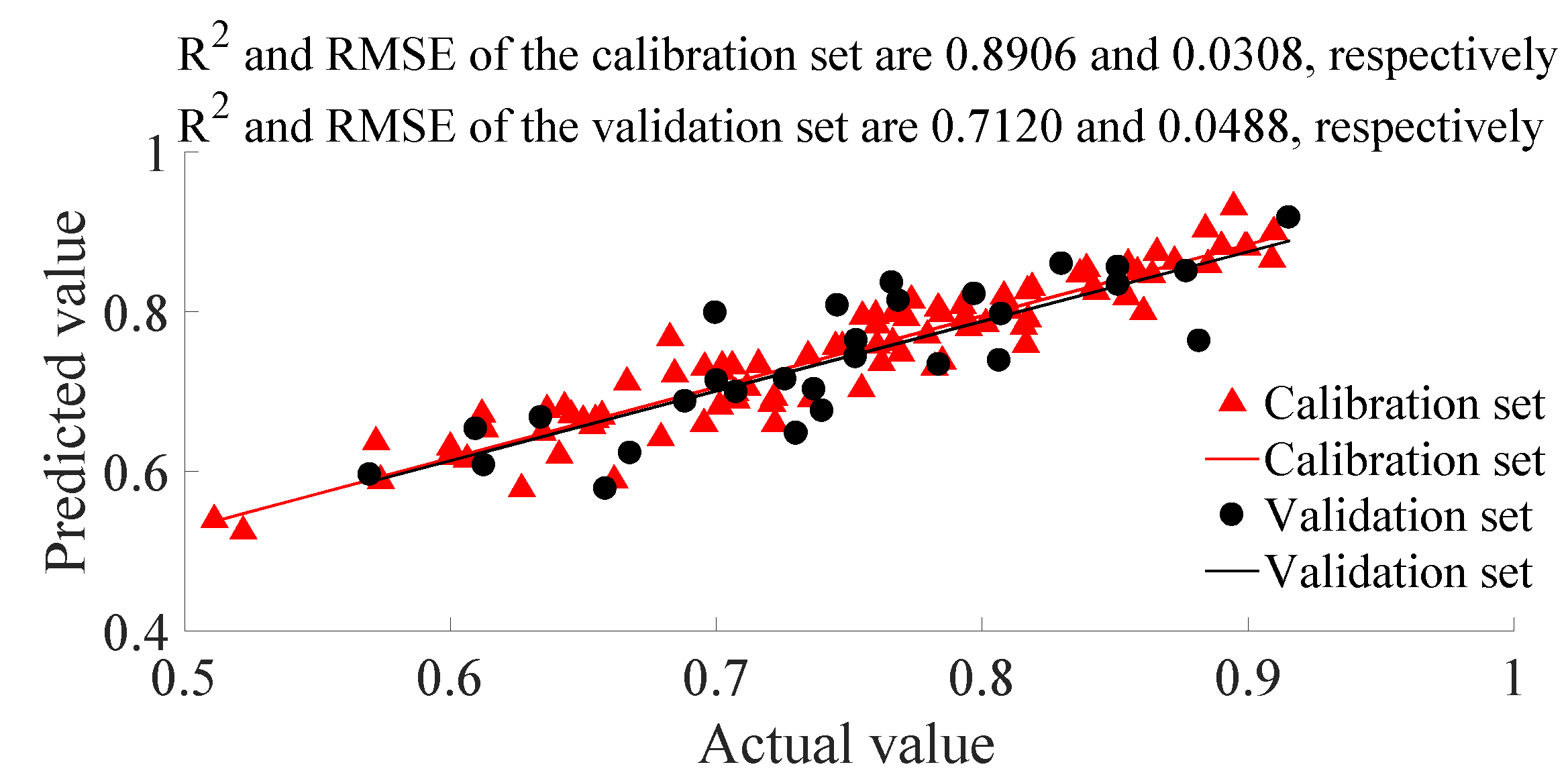

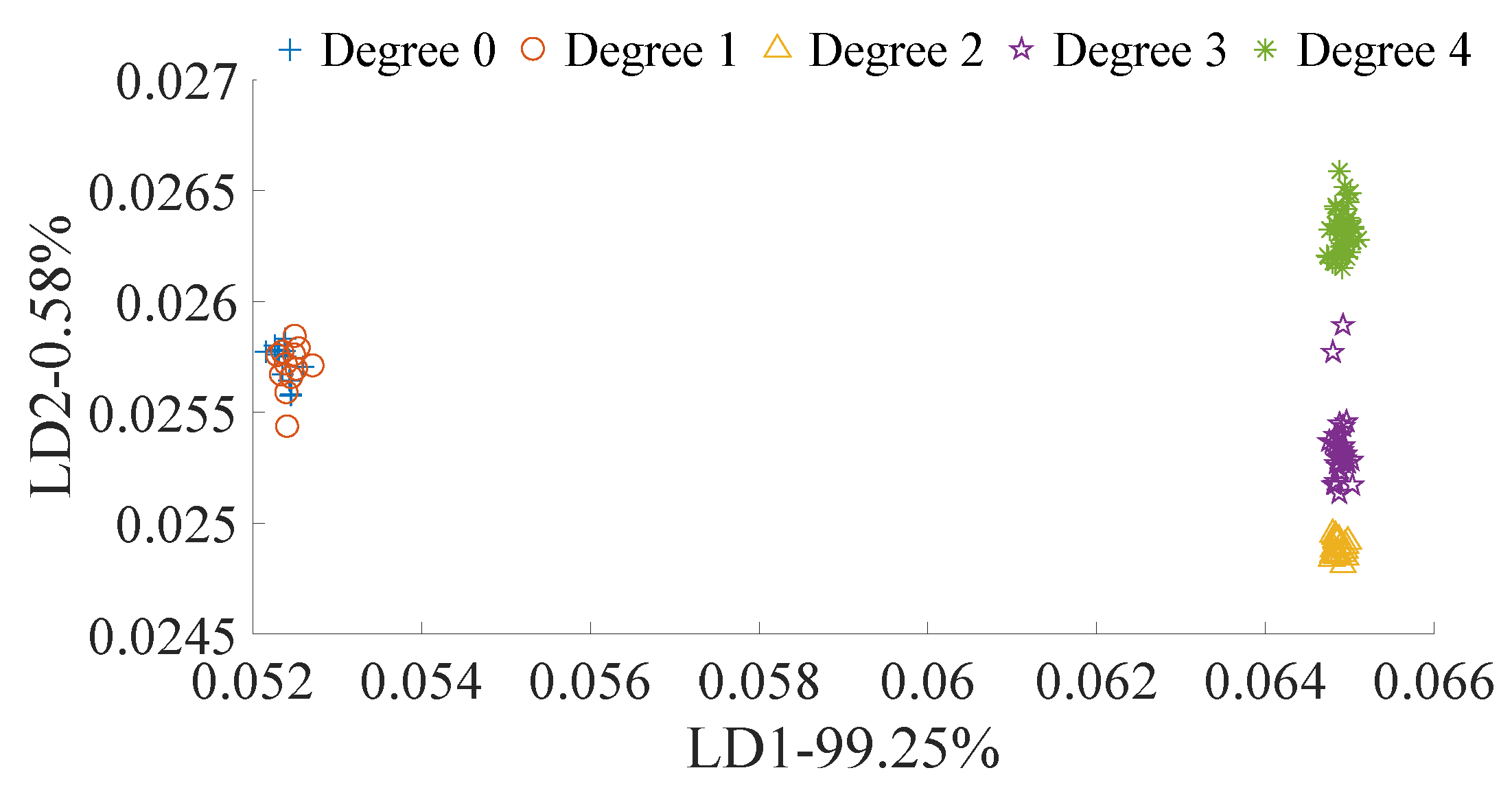
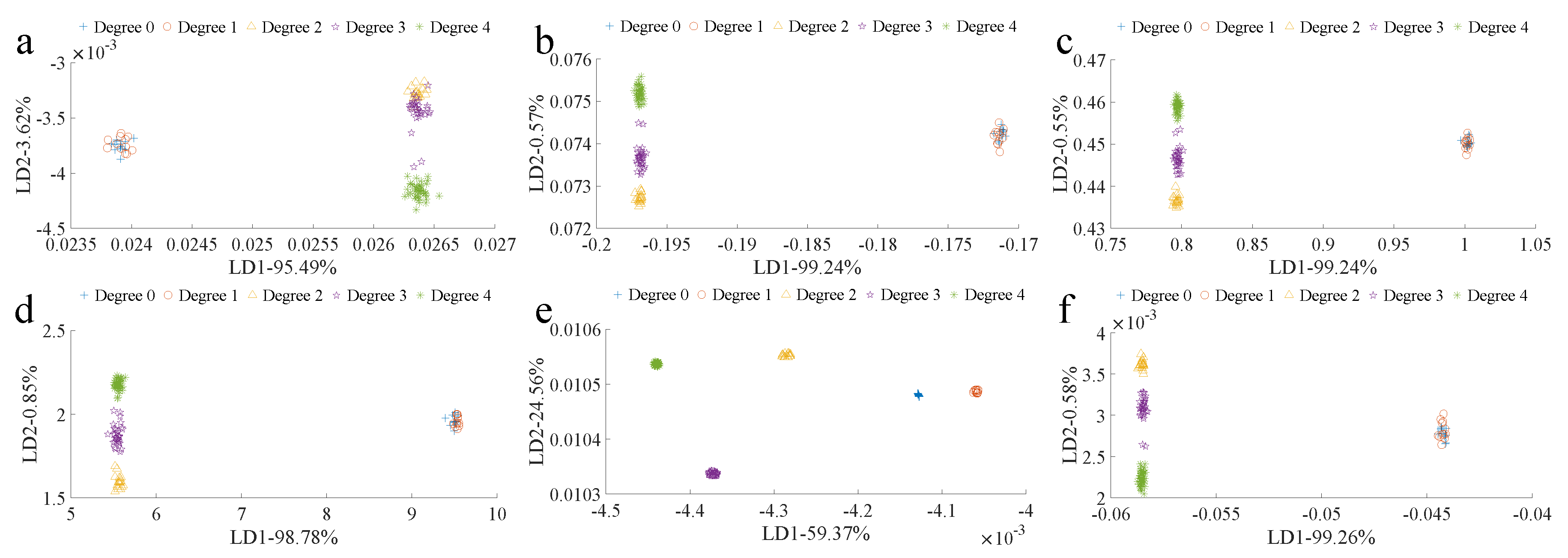
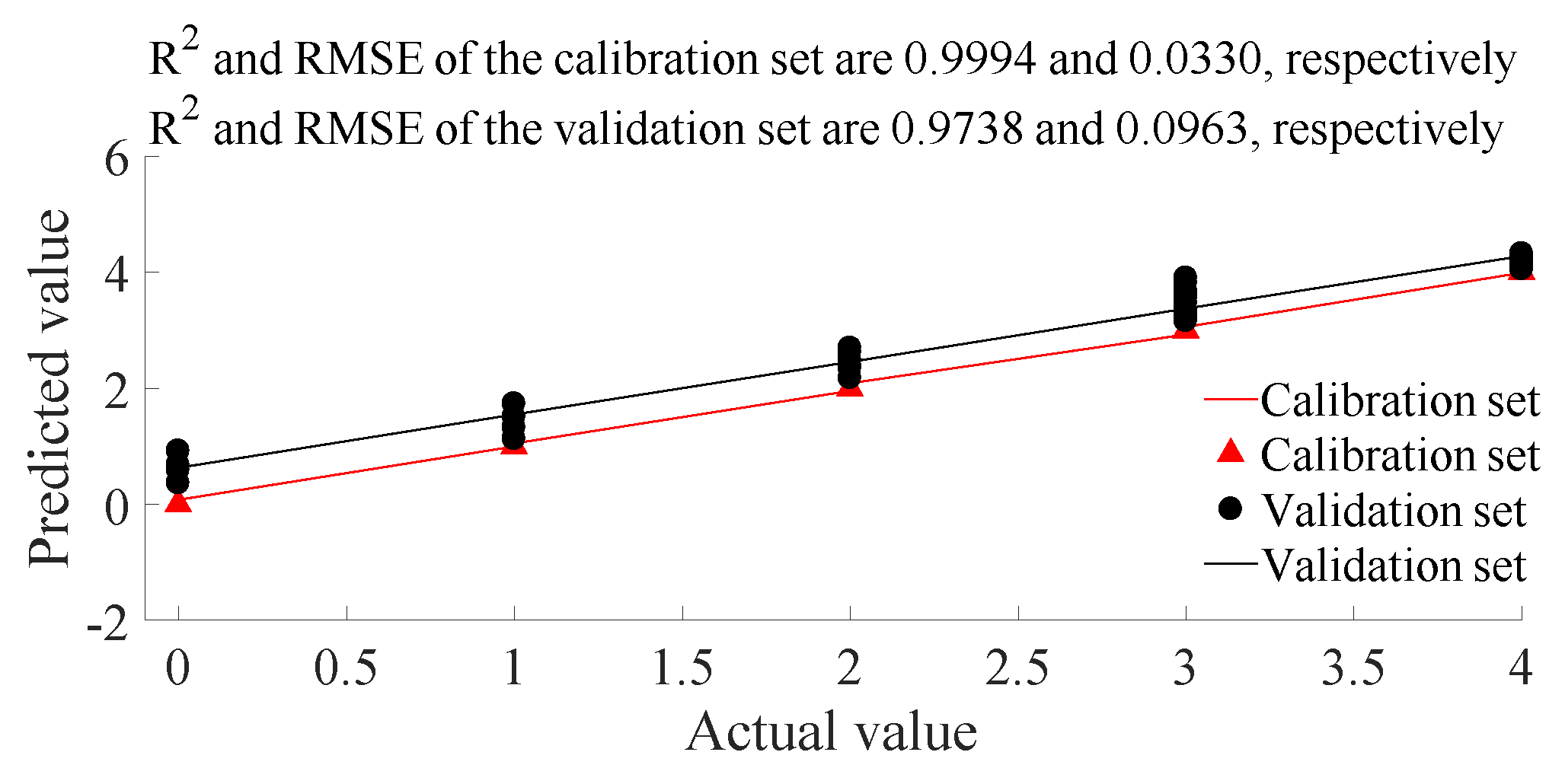

| Data Processing Methods | NS | FD | SR | LM | IM | SG | MSC | RD |
|---|---|---|---|---|---|---|---|---|
| R2 at calibration set | 90 | 0.9355 | 0.8815 | 0.8286 | 0.6247 | 0.9096 | 0.8974 | 0.9163 |
| RMSEat calibration set | 0.0273 | 0.0321 | 0.0386 | 0.0571 | 0.0280 | 0.0299 | 0.0270 | |
| R2 at validation set | 29 | 0.4185 | 0.5638 | 0.4955 | 0.4480 | 0.7053 | 0.6998 | 0.6928 |
| RMSE at validation set | 0.0702 | 0.0647 | 0.0743 | 0.0690 | 0.0527 | 0.0500 | 0.0542 |
| Selection Methods | Number of Features | Calibration Set (90 Samples) | Validation Set (29 Samples) | ||
|---|---|---|---|---|---|
| R2 | RMSE | R2 | RMSE | ||
| RCA | 278 | 0.9872 | 0.0105 | 0.3885 | 0.0904 |
| MI-SPA | 990 | 0.9101 | 0.0279 | 0.6481 | 0.0592 |
| GA | 488 | 0.8294 | 0.0385 | 0.7376 | 0.0489 |
| PCA | 118 | 0.8906 | 0.0308 | 0.7120 | 0.0488 |
© 2020 by the authors. Licensee MDPI, Basel, Switzerland. This article is an open access article distributed under the terms and conditions of the Creative Commons Attribution (CC BY) license (http://creativecommons.org/licenses/by/4.0/).
Share and Cite
Xu, S.; Lu, H.; Ference, C.; Qiu, G.; Liang, X. Rapid Nondestructive Detection of Water Content and Granulation in Postharvest “Shatian” Pomelo Using Visible/Near-Infrared Spectroscopy. Biosensors 2020, 10, 41. https://doi.org/10.3390/bios10040041
Xu S, Lu H, Ference C, Qiu G, Liang X. Rapid Nondestructive Detection of Water Content and Granulation in Postharvest “Shatian” Pomelo Using Visible/Near-Infrared Spectroscopy. Biosensors. 2020; 10(4):41. https://doi.org/10.3390/bios10040041
Chicago/Turabian StyleXu, Sai, Huazhong Lu, Christopher Ference, Guangjun Qiu, and Xin Liang. 2020. "Rapid Nondestructive Detection of Water Content and Granulation in Postharvest “Shatian” Pomelo Using Visible/Near-Infrared Spectroscopy" Biosensors 10, no. 4: 41. https://doi.org/10.3390/bios10040041
APA StyleXu, S., Lu, H., Ference, C., Qiu, G., & Liang, X. (2020). Rapid Nondestructive Detection of Water Content and Granulation in Postharvest “Shatian” Pomelo Using Visible/Near-Infrared Spectroscopy. Biosensors, 10(4), 41. https://doi.org/10.3390/bios10040041





